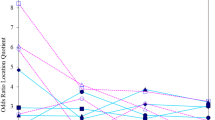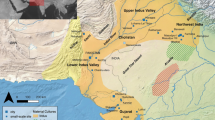In the late eighteenth and early nineteenth century a number of “Ideal” or “Utopian” type settlements were established across Ireland. These tended to be religious groupings or “model” communities associated with industry. In the southwest a number of short-lived cooperative communities were established along Owenite principles which continue to play an integral part in the radical histories of the country. This paper examines the archaeologies of these sites and analyses the role of individual in their formation and collapse and addresses the social archaeology of their construct and layout. It is suggested that contemporary hierarchical norms were actually reproduced in these communities and this segregation is reflected in the physical morphology of the settlements.




Similar content being viewed by others
REFERENCES CITED
Allen, R. (1999). Food production in Ireland—The colonial legacy. An Phoblacht; Republican News, 29 July.
Basketter, S. (2001). The Ralahine Commune: Ireland's ‘magnificent socialist experiment.' Socialist Worker 149: 8.
Butler, D. M. (2004). The Quaker Meeting Houses of Ireland, Irish Friends Historical Committee, Dublin.
Coates, C. (2001). Utopia Britannica: British Utopian Experiments 1325–1945, Diggers and Dreamers, London.
Connolly, J. (1973). Labour in Irish History, New Books, Dublin.
Coombes, J. (1970). Utopia in Glandore, Muintir Na Tíre, Butlerstown, Ireland.
Craig, E. T. (1983). An Irish Commune: The experiment at Ralahine, County Clare 1831–1833, Irish Academic Press, Dublin.
Donnachie, I. (2000). Robert Owen. Owen of New Lanark and New Harmony, Tuckwell, East Linton, Scotland.
Dooley, D. (1997). William Thompson ‘Appeal' (1825), Cork University Press, Cork, Ireland.
Engels, F. (1969). Condition of the Working Class in England, Institute of Marxism-Leninism, Moscow.
Geoghegan, V. (1989). Ralahine: Ireland's Lost Utopia. Communal Societies 9: 91–104.
Harrison, J. F. C. (1969). Robert Owen and the Owenites in Britain and America, Routledge and Kegan Paul, London.
Heritage Council (2003). Heritage Conservation Plan 3: Portlaw, County Waterford, Wordwell, Wicklow, Ireland.
Hutton, J. E. (2004). History of the Moravian Church, Kessinger, Whitefish, Montana.
McCarron, D. (1994). Making changes happen; Evolution and Revolution. Workers Solidarity, 42: 3.
McGerr, M. (2003). A Fierce Discontent: The Rise and Fall of the Progressive Movement in America, 1870–1920, Free Press, New York.
Nozick, R. (1974). Anarchy, State and Utopia, Blackwell, Oxford.
Ó Gráda, C. (1983). The Owenite community at Ralahine, County Clare, 1831–33: A reassessment. In Craig, E. T. (ed.), An Irish Commune: The Experiment at Ralahine, County Clare 1831–1833, Irish Academic Press, Dublin, pp. 193–208.
O'Mahony, P., and Delanty, G. (1998). Rethinking Irish History; Nationalism, Identity and Ideology, Palgrave, Hampshire, England.
Pankhurst, R. K. P. (1991). William Thompson: Pioneer Socialist, Pluto Press, London.
Pare, W. (1870). Co-Operative Agriculture, Longmans, London.
Tarlow, S. (2002). Excavating Utopia; why archaeologists should study “ideal” communities of the nineteenth century. International Journal of Historical Archaeology 6: 299–323.
Tobin, M. (2001). William Thompson 1775–1833. Rosscarbery Past and Present 3: 36–42.
ACKNOWLEDGMENTS
The author thanks Charles Orser for his support, expertise, comments and the McGerr reference, Sarah Tarlow for her original seminal article and for her very constructive comments here, Darragh Breen and Eileen O'Brien for sourcing material relating to William Thompson and Thomas McErlean who read and commented on this text.
Author information
Authors and Affiliations
Corresponding author
Rights and permissions
About this article
Cite this article
Breen, C. Social Archaeologies of “Utopian” Settlements in Ireland. Int J Histor Archaeol 10, 35–48 (2006). https://doi.org/10.1007/s10761-006-0003-5
Published:
Issue Date:
DOI: https://doi.org/10.1007/s10761-006-0003-5




